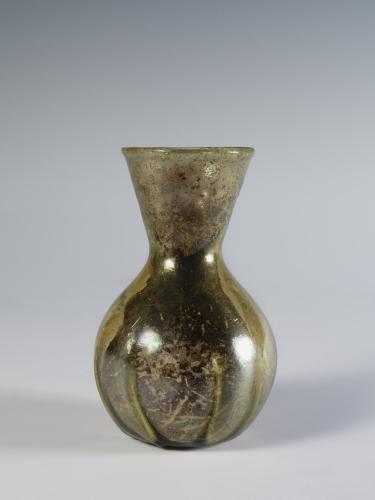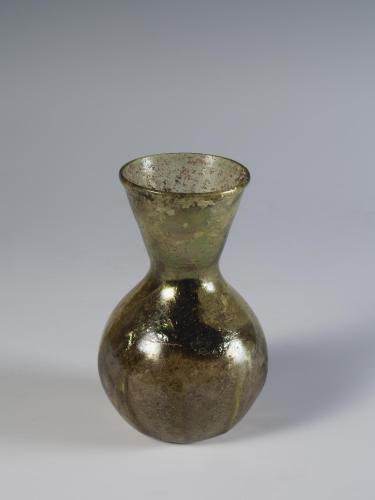Catalogue Entry 
From the Catalogue of Ancient Glass in the University of Colorado Museum
Gift of H. Medill Sarkisian and Justine Sarkisian Rodriguez (1979)
Transferred to CU Art Museum (2008)
Height: 10.2 cm
Diameter (max.): 6.1 cm
Roman, 4th century C.E.
Classification: Isings Form 104b; Harden Fabric 4
Description: Funnel mouth with rounded rim. Bulbous body, without base ring. Low relief fluting on body, resulting in nine ribs that reach halfway up body. Pontil mark on base. Green. Some iridescence and flaking. Blown, with ribs pinched during reheating.
Comment: Vessels of this sort were probably used as a table ware for wine and other liquids. The funnel neck is particularly well-suited for filling and pouring (1). Examples of this form come from all over the Roman Empire. Similar examples are Harden 1966, fig. 10; Stern 2001, nos. 104 and 105; Whitehouse 1997, no. 312; and possibly Gorin-Rosen 2004, no. 11. See also Hayes 1975, nos. 316 and 317, which have similar shapes but lack fluting.
Discussion
The green color of this glass flask comes from a small amount of natural metal in the ingredients. All sand used for making glass has a very small percentage of metals in it. Green glass is caused by one- to three-percent of iron mixed in with the sand. It is uncertain how much the ancient Roman glassmakers could control the tint of the glass, but they knew which metals caused which colors (2).
 There is a small pontil mark on the base of this flask. A pontil was used during the final shaping of glass vessels. When a vase was being blown, it was connected to a blowpipe at the mouth (top) of the vessel. When it came time to detach the vase from the blowpipe, a staff, or pontil, was heated and stuck onto the bottom of the vase. This allowed the glassworker to snap the blowpipe off of the top of the glass, and keep a hold of the vessel from the bottom. Then the glass piece was held by the pontil while the mouth was reheated and smoothed. Pontil marks show up on many flasks, and were rarely erased after the glass cooled. Before the pontil was invented, glassworkers used clamps to hold the vessel by the neck when snapping it off the blowpipe (3).
There is a small pontil mark on the base of this flask. A pontil was used during the final shaping of glass vessels. When a vase was being blown, it was connected to a blowpipe at the mouth (top) of the vessel. When it came time to detach the vase from the blowpipe, a staff, or pontil, was heated and stuck onto the bottom of the vase. This allowed the glassworker to snap the blowpipe off of the top of the glass, and keep a hold of the vessel from the bottom. Then the glass piece was held by the pontil while the mouth was reheated and smoothed. Pontil marks show up on many flasks, and were rarely erased after the glass cooled. Before the pontil was invented, glassworkers used clamps to hold the vessel by the neck when snapping it off the blowpipe (3).
Footnotes
- Gladys D. Weinberg and E. Marianne Stern, Vessel Glass. The Athenian Agora Vol. 34 (Princeton: The American School of Classical Studies at Athens, 2009): 104.
- Donald B. Harden, Roman Glass from Karanis (Ann Arbor: University of Michigan Press, 1936): 6-9.
- E. Marianne Stern, Roman Mold-Blown Glass (Toledo, Ohio: Toledo Museum of Art, 1995): 43-44.
References
- Gorin-Rosen, Y. “The Glass Vessels from the Cemetery of Horbat Rimmon,” ‘Atiqot 46 (2004): 113-124.
- Harden, D. B. “Some Tomb Groups of late Roman Date in the Amman Museum,” Annales du 3e Congres des “Journées du Verre,” (Damascus, 14-23 Novembre, 1964). Liège: 1966: 48-55.
- Hayes, J. W. Roman and Pre-Roman Glass in the Royal Ontario Museum. Toronto: 1975.
- Stern, E. M. Roman, Byzantine, and Early Medieval Glass: 10 BCE-700 CE: The Ernesto Wolf Collection. Ostfildern-Ruit: Hatje Cantz, 2001.
- Weinberg, G. D. and E. M. Stern. Vessel Glass. The Athenian Agora Vol. 34. Princeton: The American School of Classical Studies at Athens, 2009.
- Whitehouse, D. Roman Glass in the Corning Museum of Glass, v. 1. Corning, NY: Corning Museum of Glass, 1997.
